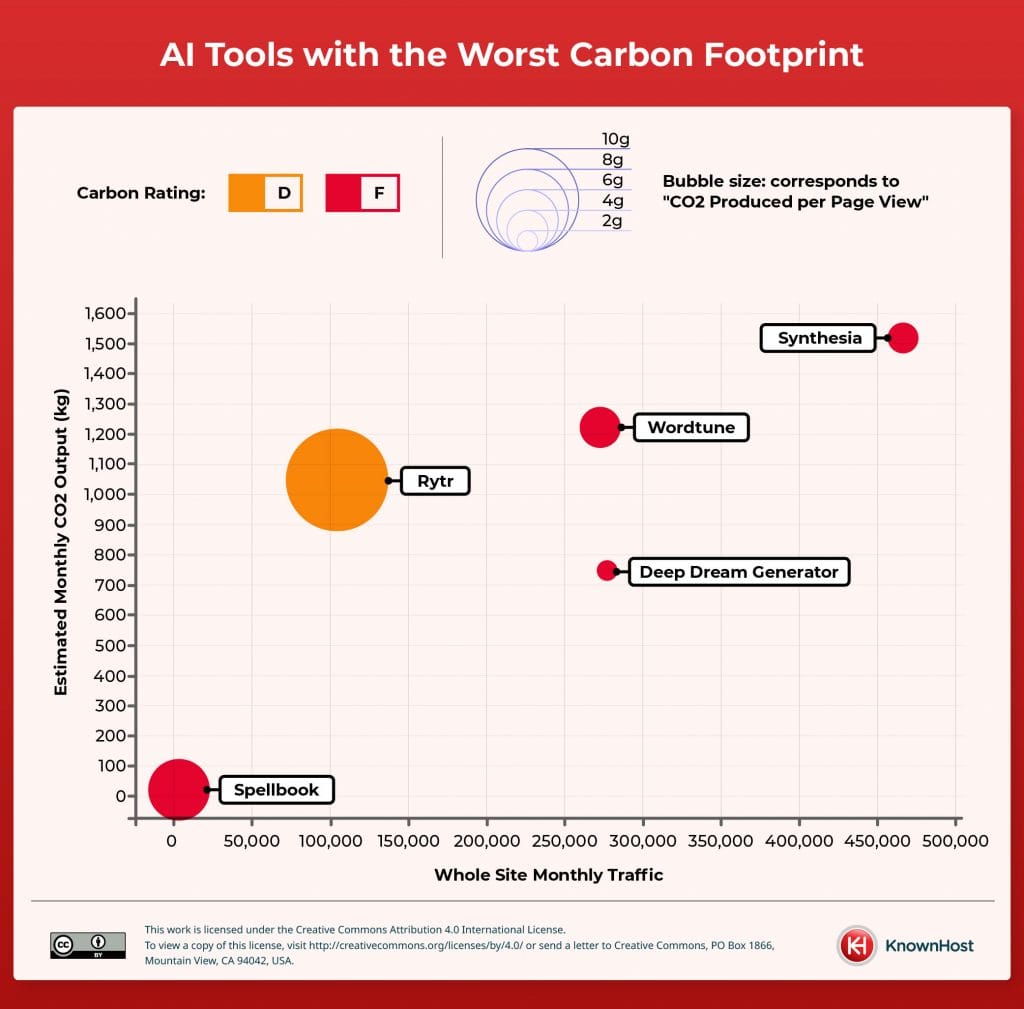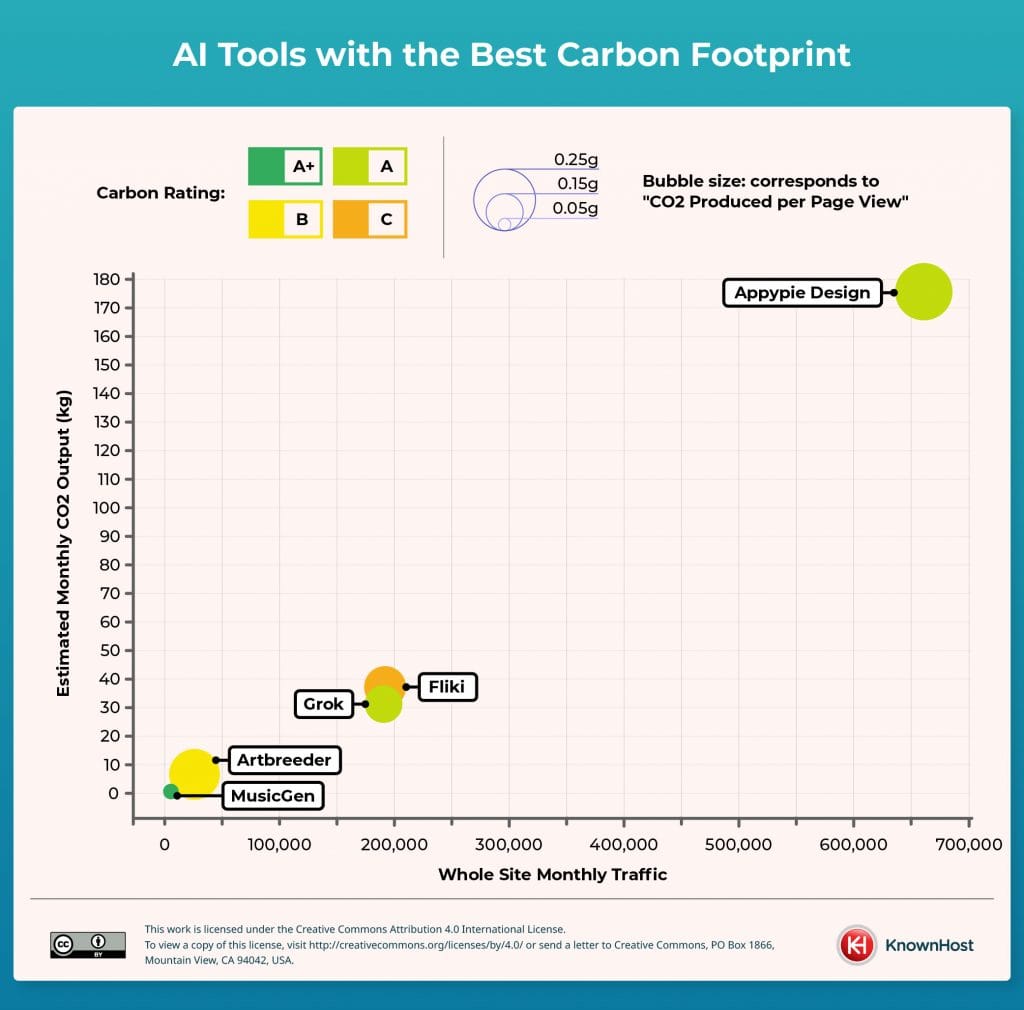Carbon Footprint of AI Tools
Last Updated: June 12, 2025
Artificial intelligence has become a popular and innovative tool which has helped to improve and transform industries across the globe, with millions of individuals benefiting from the solutions it offers. This popularity has spanned into a plethora of AI tools for many kinds of generation, such as text, image, video and more, all of which require energy-intensive processes to produce and maintain their increasingly high output. As a result, the carbon footprint of AI tools is becoming a growing concern, highlighting the need to balance innovation with environmental responsibility.
From this, concerns have been raised on the sustainability of these tools and the potential outcomes as they continue to grow in utilization and consumption. There has been a focus to bring down energy costs and carbon emissions, to ensure that these tools can continue to develop whilst balancing with environmental responsibility.
Here at KnownHost, a study was conducted to uncover the environmental impact of these tools that are growing in usage, looking at the Carbon Rating of 50 AI tools and comparing how much CO? is produced per generator.
Table of Contents:
How AI Tools Generate Carbon Emissions and Why It Matters
AI tools rely on large scale data centers that power machine learning models with thousands of processors running continuously. Each request, whether it is generating a paragraph of text, editing an image, or synthesizing a video, triggers computations across these vast server networks, consuming electricity primarily sourced from fossil fuels.
Moreover, training an AI model often involves processing massive datasets over weeks or months, multiplying the energy demand even before the tool becomes available to users. These emissions are not limited to training. Inference, or the use of AI models after training, can also be highly energy intensive when scaled to millions of users.
This matters because the growing demand for AI accelerates carbon emissions at a time when global environmental efforts aim to drastically reduce them. If left unchecked, AI could become one of the tech sector’s largest contributors to climate change. Understanding these environmental costs is critical. Not to halt progress, but to innovate responsibly and pursue greener alternatives in infrastructure and algorithm design.
AI Tools with the Worst Carbon Footprint

Rytr is the AI Tool with a high output of carbon dioxide, producing 10.1g per page view on their site. During a month, the site will receive 104,700 users on average which means 1,057 kilos of CO2 will be produced from this tool alone.

Spellbook is second, producing 6.5g of CO2 per page view, with an average monthly traffic of 3,100, but still producing 20 kilos of carbon dioxide a month overall. Wordtune produces 4.4g of CO2 per page view, totalling just over 1,200 kilograms a month due to over 250,000 users on average.
In fourth position, Synthesia produces 3.3g of CO2 per page view, with a large average of monthly traffic at 468k, totalling over 1,530 kilograms of CO2 a month. Lastly, Deep Dream Generator produces 2.7 grams of CO2 per page view and produces 750 kilograms a month on average from a traffic volume of 276k.

From the study, it was also found that the popular tool, ChatGPT, with over 164 million users a month, has the highest production of CO2, yet it has a lower production per page view of 1.59g than the top five we’ve discussed. It produces an average over 260,930 kilograms of carbon dioxide per month.
AI Tools with the Best Carbon Footprint

At the top of the list is MusicGen, which produced 0.07g of CO2 per page view. It also has a low monthly traffic with the estimated footfall of viewers producing 335 grams of carbon dioxide a month.
Grok is second with 0.17g of CO2 per page view, however it has a higher amount of traffic with an average of 190,100 users a month. Fliki has a slight increase in both areas 0.19g of CO2 produced per page view and a total traffic of 193,800 a month.
Artbreeder has another jump to producing 0.23g of CO2 per page view, but with a low traffic of 27,200 viewers per month which produced just over 6 kilos of carbon overall. Appypie Design has the largest traffic at 661,500 therefore produces 175 kilograms of carbon dioxide per month on average, however it still produces a small amount of CO2 at 0.26g per page view, which is the fifth lowest across all tested AI tools.
Ongoing Industry Efforts to Reduce Carbon Impact
As awareness grows, many companies behind AI tools are investing in greener technologies and partnerships with eco-conscious cloud service providers. For instance, OpenAI has collaborated with Microsoft Azure’s carbon-negative infrastructure to offset emissions from models like ChatGPT.
Google DeepMind has prioritized research in energy-efficient AI model training, while organizations like Hugging Face are publishing emissions transparency reports. These efforts signal a larger trend in the AI industry, emphasizing accountability and sustainability in the pursuit of innovation.
Conclusion
For the future of AI innovation, it is clear to recognise the importance of advocating for energy-efficient practices and gain insight into the changes that can be made so that the contribution to harmful emissions can be reduced. This approach can then lead to a greener future, aligning with global sustainability along with fostering a culture of technological advancement.
Methodology
For this study, a seed list of 50 Generative AI Tools was drawn up and their URLs tested by https://www.websitecarbon.com/, an online calculator that rates websites on a scale from A+ to F. These URLs were then crawled by Screaming Frog SEO Spider to find out the amount of carbon produced per page view, which was then multiplied by estimated site traffic, according to Ahrefs, to establish how much CO2 is produced.